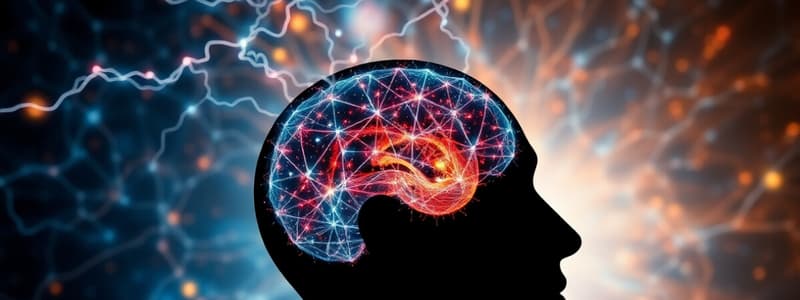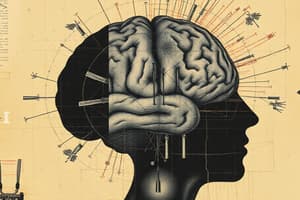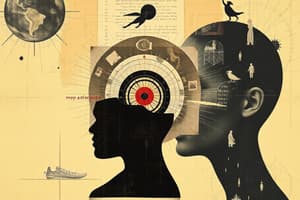Podcast
Questions and Answers
Which symptom indicates the necessity of calling an ambulance after a head injury?
Which symptom indicates the necessity of calling an ambulance after a head injury?
- Temporary dizziness
- Slight confusion
- Minor headache
- Unconsciousness of any length (correct)
What characterizes an epidural haematoma?
What characterizes an epidural haematoma?
- Occurs only in children
- Slower bleeding from a torn vein
- Life-threatening condition requiring immediate treatment (correct)
- No symptoms for an extended period
Which factor can lead to a chronic subdural haematoma?
Which factor can lead to a chronic subdural haematoma?
- Recent surgery on the skull
- Aging population with major falls
- Immediate severe symptoms after injury
- Repetitive minor head trauma (correct)
Which of the following symptoms is associated with chronic traumatic encephalopathy?
Which of the following symptoms is associated with chronic traumatic encephalopathy?
What should be done if a patient shows signs of increased intracranial pressure after a head injury?
What should be done if a patient shows signs of increased intracranial pressure after a head injury?
What is a typical treatment approach for a chronic subdural haematoma?
What is a typical treatment approach for a chronic subdural haematoma?
Which of the following is a sign of a serious head injury requiring urgent attention?
Which of the following is a sign of a serious head injury requiring urgent attention?
What is a common symptom of chronic subdural haematoma development?
What is a common symptom of chronic subdural haematoma development?
What is the definition of consciousness in the context of altered mental status?
What is the definition of consciousness in the context of altered mental status?
Which of the following describes a lethargic state?
Which of the following describes a lethargic state?
What characterizes a simple partial seizure?
What characterizes a simple partial seizure?
Which type of seizure is known to often affect children?
Which type of seizure is known to often affect children?
What is the primary feature of the ictus phase during a seizure?
What is the primary feature of the ictus phase during a seizure?
What risk factor is the most common cause of epilepsy?
What risk factor is the most common cause of epilepsy?
Which of the following is a symptom of postictal period after a seizure?
Which of the following is a symptom of postictal period after a seizure?
What does the Glasgow Coma Scale measure?
What does the Glasgow Coma Scale measure?
Which symptom is not characteristic of hypoglycaemia?
Which symptom is not characteristic of hypoglycaemia?
In the event of a seizure, which action is advised as part of immediate first aid?
In the event of a seizure, which action is advised as part of immediate first aid?
Which condition is not typically a differential diagnosis for seizures?
Which condition is not typically a differential diagnosis for seizures?
During a vasovagal syncope event, which symptom is commonly experienced prior to loss of consciousness?
During a vasovagal syncope event, which symptom is commonly experienced prior to loss of consciousness?
Which treatment is indicated for managing seizures associated with excitability?
Which treatment is indicated for managing seizures associated with excitability?
What is the recommended position for a person after they have had a seizure?
What is the recommended position for a person after they have had a seizure?
What should be done if a seizure lasts longer than five minutes?
What should be done if a seizure lasts longer than five minutes?
Which of the following is not a recommended action during a seizure?
Which of the following is not a recommended action during a seizure?
Which of these is a known trigger for vasovagal syncope?
Which of these is a known trigger for vasovagal syncope?
What is the main characteristic of traumatic brain injury?
What is the main characteristic of traumatic brain injury?
Which of the following actions is not recommended for someone who experiences an episode of hypoglycaemia?
Which of the following actions is not recommended for someone who experiences an episode of hypoglycaemia?
Which type of injury directly affects neurons at the time of trauma?
Which type of injury directly affects neurons at the time of trauma?
Which condition commonly presents with symptoms like light-headedness and sweating prior to losing consciousness?
Which condition commonly presents with symptoms like light-headedness and sweating prior to losing consciousness?
Which medication is used to enhance GABAergic inhibition in seizure management?
Which medication is used to enhance GABAergic inhibition in seizure management?
Flashcards
Consciousness
Consciousness
A state of awareness of self and surroundings.
Altered Consciousness
Altered Consciousness
A category of mental dysfunction characterized by changes in awareness, alertness, and cognitive function.
Conscious
Conscious
A state of being awake and aware of oneself and surroundings.
Confused
Confused
Signup and view all the flashcards
Lethargic
Lethargic
Signup and view all the flashcards
Epilepsy
Epilepsy
Signup and view all the flashcards
Postictal Period
Postictal Period
Signup and view all the flashcards
Grand Mal Seizure
Grand Mal Seizure
Signup and view all the flashcards
Haematoma
Haematoma
Signup and view all the flashcards
Epidural Haematoma
Epidural Haematoma
Signup and view all the flashcards
Subdural Haematoma
Subdural Haematoma
Signup and view all the flashcards
Chronic Subdural Haematoma
Chronic Subdural Haematoma
Signup and view all the flashcards
Chronic Traumatic Encephalopathy (CTE)
Chronic Traumatic Encephalopathy (CTE)
Signup and view all the flashcards
Increased Intracranial Pressure (ICP)
Increased Intracranial Pressure (ICP)
Signup and view all the flashcards
Meningism
Meningism
Signup and view all the flashcards
Focal Neuro Signs
Focal Neuro Signs
Signup and view all the flashcards
Seizure (Epilepsy)
Seizure (Epilepsy)
Signup and view all the flashcards
Numbness
Numbness
Signup and view all the flashcards
Fatigue
Fatigue
Signup and view all the flashcards
Drowsiness
Drowsiness
Signup and view all the flashcards
Partial Paralysis
Partial Paralysis
Signup and view all the flashcards
Confusion
Confusion
Signup and view all the flashcards
Agitation
Agitation
Signup and view all the flashcards
Loss of consciousness (Unconsciousness)
Loss of consciousness (Unconsciousness)
Signup and view all the flashcards
Syncope (Vasovagal attack)
Syncope (Vasovagal attack)
Signup and view all the flashcards
Hypoglycemia
Hypoglycemia
Signup and view all the flashcards
Traumatic Brain Injury (TBI)
Traumatic Brain Injury (TBI)
Signup and view all the flashcards
Concussion
Concussion
Signup and view all the flashcards
Anticonvulsant Treatment for Seizures
Anticonvulsant Treatment for Seizures
Signup and view all the flashcards
NICE Guideline CG137
NICE Guideline CG137
Signup and view all the flashcards
Seizure Emergency
Seizure Emergency
Signup and view all the flashcards
Vasovagal Syncope (Fainting)
Vasovagal Syncope (Fainting)
Signup and view all the flashcards
Vasovagal Attack
Vasovagal Attack
Signup and view all the flashcards
First Aid for Seizures
First Aid for Seizures
Signup and view all the flashcards
Bringing Someone Around from a Seizure
Bringing Someone Around from a Seizure
Signup and view all the flashcards
Possible Triggers of Seizures or Syncope
Possible Triggers of Seizures or Syncope
Signup and view all the flashcards
Study Notes
Altered Consciousness
- Consciousness is the state of awareness of self and surroundings.
- Altered consciousness and impaired mental functions are different categories of dysfunction. Localizable deficits, dementia/Alzheimer's disease and other conditions fall under impaired mental functions.
- Consciousness levels range from alert and aware (conscious) to confused (disoriented, impaired judgment, needing cues) to lethargic (stupor, needing strong stimuli to respond) to unconscious (syncope, coma).
- Sleep is NOT considered unconsciousness.
- Consciousness levels are measured using scales, like the Glasgow Coma Scale.
Epilepsy
- Epilepsy is characterized by recurrent seizures, arising from abnormal, synchronous neuronal firing in the central nervous system (hyperexcitability and hypersynchronisation).
- Seizures are usually brief (1-2 minutes) and self-limiting, often followed by a period of post-ictal depression.
- Common causes/risk factors include idiopathic cases (75%), congenital defects, genetic factors (channelopathies), drugs/alcohol, sympathomimetics, antidepressants, antipsychotics, arteriovenous malformations, head trauma, infections, vascular disease, neoplasms, and degenerative diseases.
- Symptoms may include altered consciousness, clonic movements (rhythmic jerking), tonic positions (rigid postures), and other variable neurologic deficits.
Types of Seizures
- Partial Seizures: Begin in one hemisphere.
- Simple: no change in consciousness.
- Complex: alteration in consciousness. Jacksonian march (clonic movement following homunculus) is indicative of structural brain disease.
- Generalized Seizures: Begin in both hemispheres simultaneously.
- Common types include absence (petit mal) seizures (often in children) and grand mal (tonic-clonic) seizures, which can include loss of consciousness and bowel/bladder control.
Stages of a Seizure
- Prodrome: Mood/behavior changes before the seizure.
- Aura: Immediate sensations or symptoms preceding the seizure, often indicating the seizure's origin (e.g., temporal lobe aura with epigastric sensation or psychic aura).
- Ictus: The seizure itself.
- Postictal Period: Occurs after the seizure, with symptoms of numbness, headache, fatigue, drowsiness, partial paralysis, confusion, agitation, loss of consciousness/unresponsiveness, and loss of bowel/bladder control.
Treatment and Management
- Treatment typically involves anticonvulsant medications to reduce neuronal excitability (e.g., Phenytoin, Carbamazepine) or enhance GABAergic inhibition (e.g., Phenobarbital, benzodiazepines, Vigabatrin, Tiagabine).
- NICE Guideline CG137 is a resource for diagnosis and management.
- First aid for seizures involves protecting the person from injury, noting the duration, looking for epilepsy identification, placing them in the recovery position after the seizure, staying with the person and reassuring them. Do NOT restrain them, put anything in their mouth, move them unless in danger, or give them anything to eat or drink until fully recovered.
Differential Diagnosis
- Syncope (vasovagal attack)
- Cardiac arrhythmias
- Migraine
- Hypoglycemia
- Panic attacks
Vasovagal Syncope
- Vasovagal syncope (or attack) is a short-term reduction in blood pressure and flow to the brain, causing a transient loss of consciousness.
- It's common, particularly in younger people.
- Triggers include extreme emotions, pain, prolonged standing/heat exposure, and phobias.
- Symptoms include light-headedness, sweating, pallor, tunnel vision, feelings of heat or cold. During the episode, there is a loss of consciousness with spontaneous return in usually less than a minute
- Physical exam should quickly return to normal.
- Referrals are appropriate for first-time occurrences, tongue-biting (suggesting an epileptic seizure), prolonged pallor (suggesting anemia), or other atypical findings.
Hypoglycemia
- Hypoglycemia is more common than hyperglycemia.
- Diabetic individuals can experience rapid drops in blood glucose due to skipped meals, exercise, illness, or insulin overdoses.
- Signs include unusual behavior/aggression, confusion, pallor, shakiness, sweating, rapid breathing, fast pulse, and potential seizures.
- Immediate treatment involves giving sugary foods/drinks; if improvement occurs, continue until full recovery in ~10 minutes. Medical checkup is still necessary, as blood sugar levels can further drop. If hypoglycemia is not resolving or worsens, call an ambulance.
Traumatic Brain Injury (TBI)
- TBI involves brain damage resulting from impact, penetration or rapid skull movement.
- It's a leading cause of death in young adults.
- Severity is determined by Glasgow Coma Scale.
- Injuries are divided into primary (trauma) and secondary (chemical cascades).
- Primary Injuries: direct damage.
- Secondary Injuries: damage that develops in the hours or days following the initial trauma. This can lead to additional neuronal loss.
- Common focal injuries: coup contusion/laceration, contrecoup contusion, intracranial hematoma, infection (e.g., meningitis/abscess).
- Common diffuse/primary injuries: axonal shearing.
Head Trauma – Concussion
- A brief alteration of brain function from a blow to the head.
- Symptoms include dazedness, disorientation, diplopia, headache, tinnitus, nausea, dizziness, difficulty sleeping, photophobia, memory loss, changes in taste/smell. Medical evaluation is essential.
Head Trauma – Hematomas
Epidural Hematoma
- Artery tear, causing rapid bleeding with brain tissue compression.
- Life-threatening within hours to 48 hours, requiring immediate medical attention.
- Symptoms may include transient loss of consciousness (typically 5 minutes), regaining consciousness, and continuing activity, followed by progressive lethargy/weakness/altered consciousness.
Subdural Hematoma
- Vein tear, causing slower leakage and less compression.
- Chronic subdural hematomas (less acute) may not manifest for months or years, with symptoms developing gradually.
- Symptoms can include a headache, nausea, focal symptoms (e.g., ataxia, motor weakness, sensory loss).
Chronic Traumatic Encephalopathy (CTE)
- CTE results from repeated brain trauma (e.g., boxers, football players).
- Progressive, degenerative changes, with symptoms appearing months to decades after the last trauma.
- Tissue changes include atrophy of cerebral hemispheres, medial temporal lobe, thalamus, mammillary bodies, and brainstem. Symptoms include memory loss, confusion, impaired judgment, aggression, explosive anger, depression, and progressive dementia.
Assessment for Head Injury
- Call an ambulance for unconsciousness, abnormal breathing, serious wounds/suspected skull fractures, bleeding/fluid discharge from nose/ear/mouth, lack of coordination, speech/vision disturbances, unequal pupils, weakness/paralysis, dizziness, neck pain/stiffness, fits, or vomiting.
Studying That Suits You
Use AI to generate personalized quizzes and flashcards to suit your learning preferences.
Description
This quiz explores key concepts of altered consciousness and epilepsy. It covers definitions, levels of consciousness, and seizure characteristics related to epilepsy, including causes and risk factors. Test your understanding of these essential topics in neurological function.




